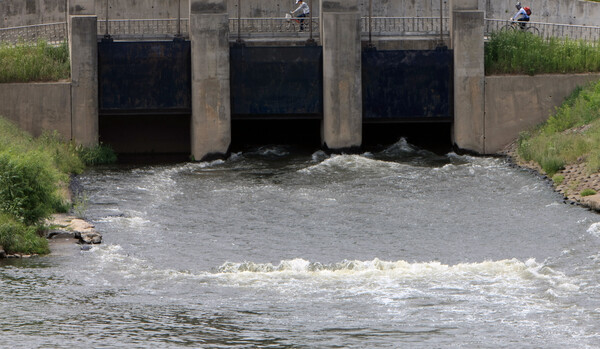포스텍 조강우 교수팀, 수소 발생 효율 높이는 요소 산화 반응 촉매 개발
KIST와 공동연구…국제학술지 『어드밴스드 펑셔널 머티리얼즈(Advanced functional materials)』에 최근 게재

포스텍(환경공학부 조강우 교수·박사과정 김지선 씨 연구팀이 KIST(한국과학기술연구원)과의 공동 연구를 통해 오염된 생활하수를 사용해 친환경 에너지인 수소 생산 반응의 효율을 높일 새로운 촉매를 개발했다.
이번 연구는 국제 학술지 중 하나인 『어드밴스드 펑셔널 머티리얼즈(Advanced functional materials)』에 최근 게재됐다.
화석연료로 인한 환경오염 문제가 심각해짐에 따라 수소에 대한 관심이 증가하고 있다. 물을 전기분해 하여 수소를 생산하는 수전해(Water Electrolysis) 기술은 지구상에 풍부한 물을 사용해 지속가능한 공정이지만, 수소 생산과 동시에 발생하는 산소 발생 반응의 속도가 매우 느려 에너지 전환 효율이 매우 낮았다.
최근 학계에서는 요소 산화 반응을 수소 발생 반응과 결합해 이러한 문제를 해결하고 있다. 소변에 포함된 오염물질인 요소는 산화 과정에서 많은 양의 에너지를 방출해 이를 활용하면 수소 발생 효율을 높일 수 있음은 물론, 화장실 폐수를 정화할 수 있다. 결국, 수소 발생 반응과 폐수 처리 효율을 높이기 위해서는 요소 산화 반응을 효과적으로 촉진할 수 있는 촉매가 필요하다.
![이번 연구를 주도한 포스텍 조강우 환경공학부 교수(오른쪽)와 박사과정 김지선 씨. [사진출처(Photo source) = 포스텍(POSTECH)]](https://cdn.waterjournal.co.kr/news/photo/202403/74325_46738_920.jpg)
연구팀은 요소 산화 반응의 효율을 높이기 위해 니켈(Ni) 금속에 철(Fe)과 옥살산(Oxalate)을 결합한 니켈-철-옥살산(이하 O-NFF) 촉매를 만들었다. 이 촉매는 나노미터 크기의 입자들이 파편 형태로 조합되어 표면적이 매우 크다. 이러한 특성으로 더 많은 반응 물질을 흡착함으로써 요소 산화 반응 속도를 높일 수 있다.
실험 결과, 연구팀의 O-NFF 촉매는 수소 발생에 필요한 전압을 1.47V RHE(0.5 A/cm2)로 낮추는 데 성공했으며, 수산화칼륨(1M)과 요소(0.33M)가 혼합된 용액에서도 높은 반응 속도를 보였다. RHE(Normal Hydrogen Electrode)는 표준 수소 전극을 말한다. RHE는 수소 기체와 액체 수소의 중간 평형상태인 표준 상태에서 전위가 0V로 정의된다. 테펠 기울기(TeFal) = 12.1mV/dec로, 테펠(Tefel)은 전기화학적 반응 속도를 나타내며, 값이 높을수록 촉매의 높은 활성을 나타낸다.
![포스텍 환경공학부 조강우 교수 연구팀이 개발한 촉매 반응 모식도(요소 산화 반응 촉진). [그림출처(picture source) = 포스텍(POSTECH)]](https://cdn.waterjournal.co.kr/news/photo/202403/74325_46739_948.jpg)
또, 연구팀은 방사광가속기를 이용한 광전자·X선 흡수 분광 실험에서도 이 촉매가 요소의 산화 반응을 촉진함을 확인했다.
이번 연구를 이끈 조강우 교수는 “생활 하수도 정화하면서 친환경 에너지원인 수소 생산 효율을 높일 수 있는 촉매를 개발했다”며, “금속과 유기물로 만든 O-NFF 촉매로 산업용 전기분해 수소 생산 효율이 향상되길 바란다”는 말을 밝혔다.
한편, 이번 연구는 한국연구재단 중견연구자지원사업, 미래수소원천기술개발사업, 국가슈퍼컴퓨팅센터의 지원으로 진행됐다.
[원문보기]
“Find Pearls in the Soil” Unveiling the Magic of Hydrogen Production from Municipal Sewage
POSTECH Professor Kangwoo Cho’s team develops a catalyst for the urea oxidation reaction, enhancing hydrogen generation efficiency
Professor Kangwoo Cho and PhD candidate Jiseon Kim from the Division of Environmental Science & Engineering at Pohang University of Science and Technology (POSTECH) collaborated with the Korea Institute of Science and Technology (KIST) to devise a novel catalyst aimed at enhancing the efficiency of reactions using contaminated municipal sewage to produce hydrogen?a green energy source. Their research recently featured in the international journal ‘Advanced Functional Materials.’
With the growing environmental concerns of pollution associated with fossil fuel, hydrogen has garnered increased interest. Water electrolysis technology is a sustainable process that leverages Earth’s abundant water to produce hydrogen. However, the concurrent oxygen evolution reaction during hydrogen production is notably slow, resulting in a considerably low energy conversion efficiency.
Lately, the academic community has been tackling this issue by integrating the urea oxidation reaction with the hydrogen generation reaction. Urea, a pollutant found in urine, releases a significant amount of energy during its oxidation process, offering a potential means to enhance both the efficiency of hydrogen generation and the purification of toilet wastewater. Ultimately, it is necessary to find a catalyst that can effectively drive the urea oxidation reaction, thereby amplifying the efficiency of both hydrogen generation and wastewater treatment.
In pursuit of increased efficiency in the urea oxidation reaction, the team created a catalyst known as nickel-iron-oxalate (O-NFF). This catalyst combines iron (Fe) and oxalate on nickel (Ni) metal, resulting in an expansive surface area characterized by nanometer-sized particles in fragment form. This unique property enables the catalyst to adsorb more reactants, facilitating an accelerated urea oxidation reaction.
In experiments, the O-NFF catalyst devised by the team successfully lowered the voltage required for hydrogen generation to 1.47 V RHE*1 (at 0.5 A/cm2) and exhibited a high reaction rate even when tested in a mixed solution of potassium hydroxide (1 M) and urea (0.33 M) with a Tafel slope*2 of 12.1 mV/dec. The researchers further validated the catalyst’s efficacy by confirming its promotion of the urea oxidation reaction through photoelectron/X-ray absorption spectroscopy using a radiation photo accelerator.
Professor Kangwoo Cho who led the research stated, “We have developed a catalyst capable of purifying municipal sewage while simultaneously enhancing the efficiency of hydrogen production, a green energy source.” He added, “We anticipate that O-NFF catalysts, synthesized from metals and organics, will contribute to the improved efficiency of industrial electrolysis hydrogen production.”
The research was sponsored by the Mid-Career Researcher Program and the Hydrogen Source Technology Development Program of the National Research Foundation of Korea, and the National Supercomputing Center.
[출처=포스텍(POSTECH)(https://www.postech.ac.kr/eng/find-pearls-in-the-soil-unveiling-the-magic-of-hydrogen-production-from-municipal-sewage/#post-27221) / 2024년 3월 7일]
[논문 출처=『어드밴스드 펑셔널 머티리얼즈(Advanced functional materials)』(https://onlinelibrary.wiley.com/doi/10.1002/adfm.202315625)]
[번역 = 배철민 편집국장 겸 글로벌물산업정보센터장]

